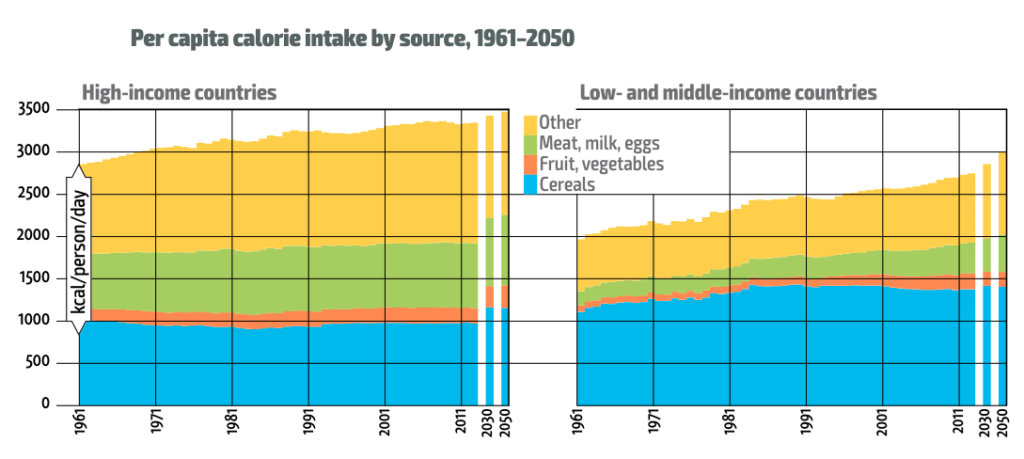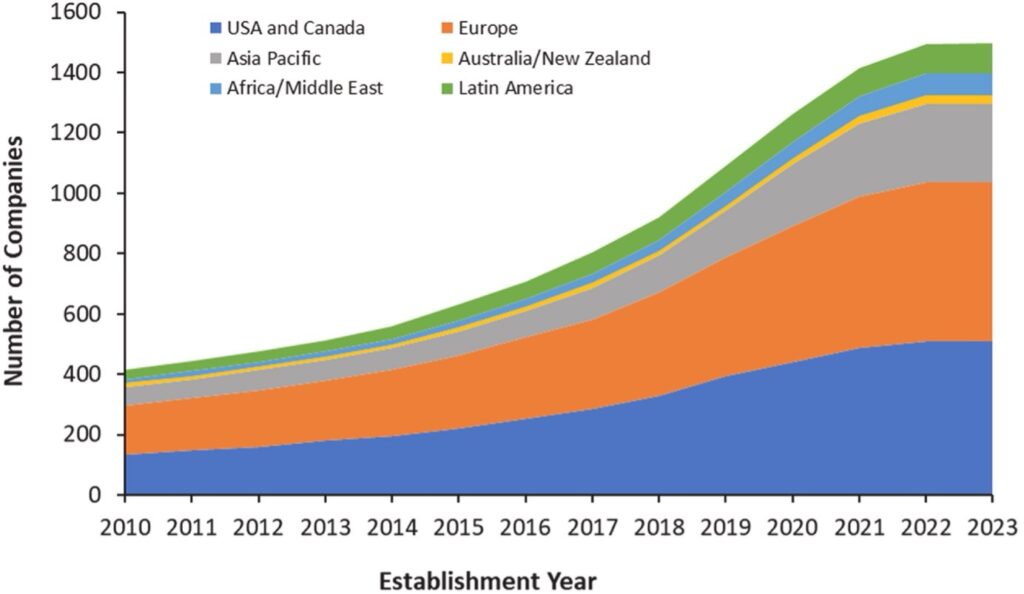Consumer awareness, preferences, and behaviours play a significant role in shaping the food system. Evolving consumer preferences, awareness of sustainability, and changing dietary habits drive shifts in food production methods, marketing strategies, and supply chain practices, shaping the trajectory of the food system.
This section presents selected data on key trends within consumption:
- Calorie intake related to dietary choices
- Acceptability of plant-based and vegan diets
1. Calorie Intake Related to Dietary Choices
Trends and projections
Today’s diet is the prime cause of the ‘triple burden’ of malnutrition and environmental degradation and the future dietary choices is one of the key uncertainties in the global food system as described in (FAO, 2022). Globally, according to the Global Panel report, food (calorie) demand will rise between 49% and 56%, depending on the assumptions used. Global Panel and FAO projections suggest that demand for animal products (dairy, meat, fish), as well as for vegetable oils, sugar, ultra-processed foods, and high-fat and salty snacks is expected to grow as well. The gap between High-Income Countries (HICs) and Low- and Middle-Income Countries (LMICs) in terms of per capita calorie intake will be reduced towards 2050 but the source of calories will vary (Figure and FAO, 2017). What exactly people will be eating in cities and rural areas, depends on multitude of factors.
Implications

Several factors directly influence dietary choices such as purchasing power, urban lifestyle, food environment, social influences, and interest in healthy and sustainable diets. Current trends show a positive correlation between urbanisation and an increase in calories. Projections suggest that as more people will live in urban centres in the future and will spend more on food, accelerated growth in consumption of meat and slower growth in consumption of fruits and vegetables is anticipated.
This in combination with the growing consumption of ultra-processed foods, has well-known deleterious health implications (like micronutrient deficiencies and obesity) for consumers is anticipated (FAO, 2017).
2. Acceptability of Plant-based and Vegan Diets
Trends and projection
Over the last three years, research on plant-based foods has tripled, and the number of vegans in the U.S. increased by 500%, from 4 million in 2014 to 19.6 million in 2017. In the U.K., 21% of people identify as flexitarian, and 1 in 8 as vegetarian or vegan, while countries like Germany, Italy, and Spain have seen significant rises in plant-based or flexitarian populations. Globally, 40% of consumers aim to reduce animal protein intake, and 10% avoid red meat entirely. Reflecting this trend, the plant-based meat alternatives market is projected to grow from USD 1.6 billion in 2019 to USD 3.5 billion by 2026, with plant-based burgers, sausages, and patties leading sales. In parallel, U.S. meat sales declined by 5% from 2015 to 2019, underscoring the growing shift toward plant-based diets (Abe-Inge et al., 2024 and Alcorta et al., 2021).
Implication
This emerging trend of plant-based and vegan diets is linked to digitisation and innovation in plant-based foods (Hassoun, Boukid et al. 2022). Many food industries have leveraged people’s awareness of the impacts and ethical concerns around animal-based diets and are marketing plant-based alternatives. It reduces pressure on natural resources such as land and water, as plant-based foods typically require fewer resources to produce compared to animal products.

Source: Alternative protein company database, Good Food Institute
This shift also promotes sustainability by lowering greenhouse gas emissions associated with animal agriculture, contributing to efforts to mitigate climate change and improve environmental stewardship. However, these products are typically ultra-processed, and their health and environmental impacts are not comprehensively researched (Abe-Inge et al., 2024 and FAO 2022).
Please email info@foresight4food.net if we are missing a data update.